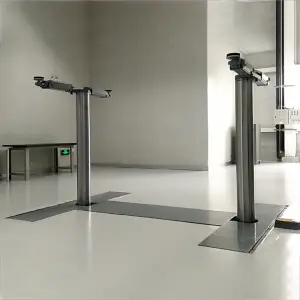****
Cylinders are one of the most fundamental shapes found in both mathematics and everyday life. Comprising two parallel circular bases connected by a curved surface, cylinders are a perfect blend of simplicity and practicality. From the mundane to the extraordinary, the use of cylinders extends across various fields, including engineering, architecture, manufacturing, and even art. In this article, we will delve into the geometry of cylinders, their practical applications, and their importance in various aspects of our daily lives.
Understanding the Geometry of Cylinders
A cylinder is defined in mathematical terms as a three-dimensional geometric shape with two parallel bases that are congruent circles. The key components of a cylinder include its radius (r), height (h), and the curved surface area. The formula for the volume (V) of a cylinder is given by:
\[ V = \pi r^2 h \]
where \( \pi \) (approximately 3.14159) is a constant that represents the ratio of the circumference of any circle to its diameter. The curved surface area (A) of a cylinder can be calculated using the following formula:

Exploring the Fascinating World of Cylinders: Understanding Their Geometry, Applications, and Importance in Everyday Life
\[ A = 2\pi rh + 2\pi r^2 \]
This formula encompasses the areas of the two circular bases in addition to the curved surface area that wraps around the sides. Understanding the geometry of cylinders is essential not only in mathematics but also in solving real-world problems involving volume and surface area.
Practical Applications of Cylinders
Cylinders are ubiquitous in our lives, often found in everyday objects and structures. One of the most common applications of cylinders is in the field of engineering, particularly in the design and manufacture of objects such as pipes and tanks. For instance, water pipes used in plumbing systems are typically cylindrical in shape, which allows for the efficient flow of water. Similarly, storage tanks for petroleum and other liquids often take the form of cylinders to maximize storage capacity while minimizing the amount of material needed to construct them.
In the manufacturing industry, cylinders play a crucial role in the production of items such as cans, bottles, and other containers. The cylindrical shape is advantageous because it provides strength and structural integrity while allowing for easy stacking and storage. Moreover, cylinders are also prevalent in the field of automotive engineering. Engine cylinders, for example, house the combustion process that powers internal combustion engines. Their design and dimensions directly impact the engine’s efficiency and performance.
Cylinders in Architecture and Design
The architectural domain showcases the aesthetic and functional beauty of cylinders. Numerous buildings and structures incorporate cylindrical elements, from towers and silos to decorative columns and sculptures. The use of cylindrical shapes in architecture not only adds visual interest but also allows for the distribution of structural loads more evenly. For instance, the famous Leaning Tower of Pisa features a cylindrical design that has captivated tourists for centuries.
Furthermore, modern interior design often highlights cylindrical forms through furniture pieces such as tables, vases, and lamps. The sleek lines of cylindrical objects can create a sense of harmony and balance within a space, contributing to an overall aesthetic appeal. Cylinders can also be used in lighting design, where cylindrical lamps can direct light in focused beams, enhancing the ambiance of a room.
The Importance of Cylinders in Science and Technology
Cylinders are not only integral to engineering and design but also play a significant role in various scientific applications. In laboratories, cylindrical containers are often used for holding liquids and conducting experiments. Test tubes, beakers, and graduated cylinders are all examples of cylindrical vessels that facilitate precise measurements and reactions in scientific research.

Exploring the Fascinating World of Cylinders: Understanding Their Geometry, Applications, and Importance in Everyday Life
In technology, the concept of cylinders extends to fields such as aerospace. Rocket fuel tanks are often designed as cylinders to internalize the pressures associated with fuel storage and transport. The aerodynamic properties of cylindrical shapes also play a critical role in the design of vehicles and aircraft, contributing to their fuel efficiency and stability during motion.

Exploring the Fascinating World of Cylinders: Understanding Their Geometry, Applications, and Importance in Everyday Life
Conclusion
The importance of cylinders in our world cannot be overstated. From their fundamental role in geometry to their practical applications in engineering, architecture, and science, cylinders are a vital part of both the physical and abstract facets of our lives. As we continue to explore and innovate, the cylinder remains a symbol of versatility and functionality, reminding us of the brilliance of geometric principles in shaping our reality.Quick Lift


